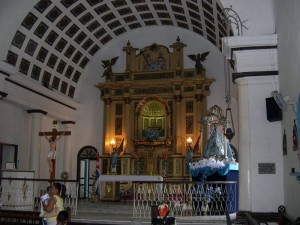OUR LADY OF REGLA
The story of the Virgin of Regla, dates from the fourth century, in Hippo, site based in North Africa, through the work of Bishop Augustine, who died in 443 and whose followers brought the image of Spain, 13 years later since been venerated in the Iberian country and elsewhere in the world where he was born.
The Augustinian monks placed the deity, who was black, in a chapel overlooking the sea and finally in the monastery of None in the Spanish province of Cadiz where he was born and raised devotion, which reached its apogee in the 18th century, including a imposing procession through the streets of the place every September 8.
 Altar de la iglesia de Nuestra Señora de Regla, que data de 1818.
Altar de la iglesia de Nuestra Señora de Regla, que data de 1818.
Some authors place the arrival in Cuba of the Virgin of Regla, in 1660 or between l688 and l690, at the initiative of a Peruvian, on land near the Bay of Havana, but it was not until l805 that the famous Bishop Espada founded the church leaves, it takes its current form l3 years later.
Following tradition, the place chosen was the town of Regla overseas, which is named after the virgin and the famed Cuban writer Alejo Carpentier called “Magic City” and where many devotees flock daily, including people who practice the rites of the Santeria.
In the temple, simple and bright, Our Lady of Regla, chairs the space, while life goes out to the inhabitants of the village and where people coming from the capital reached by boat, many in search of prayers to invoke the saint, which they say has great powers.
For a long time believers in the Regla de Ocha or Santeria, come to that place of worship perennial, because according to them the Black Madonna represents Yemaya, called the goddess of the oceans, but the Catholic religion does not recognize such approaches, as in the case of St. Lazarus.
Cuban exiles relocated the Virgin of Regla to Miami after the massive exodus from the island but still there is no Catholic church bearing his name in this city South Florida.#
LA VIRGEN DE REGLA
La historia de la Virgen de Regla, se remonta al siglo IV, en Hipona, sitio radicado en el norte de Africa, por obra del Obispo San Agustín, quien murió en el 443 y cuyos seguidores trajeron la imagen a España, 13 años después y desde entonces se venera en el país ibérico, así como en otros lugares del mundo donde fue llevada.
Los monjes agustinos, ubicaron la divinidad, que era negra, en una ermita frente al mar y finalmente en el monasterio de Chipiona, en la provincia española de Cádiz donde nació y creció la devoción, que alcanzó su apogeo en el siglo 18, incluida una imponente procesión que recorre las calles del lugar cada ocho de septiembre.

Altar de la iglesia de Nuestra Señora de Regla, que data de 1818.
Algunos autores ubican la llegada a Cuba de la Virgen de Regla, en 1660 o entre los años l688 y l690, por iniciativa de un peruano, en un terreno próximo a la Bahía de La Habana, pero no fue hasta l805, que el conocido Obispo Espada, deja fundada la iglesia, que adopta su forma actual l3 años más tarde.
Siguiendo la tradición, el lugar escogido fue el ultramarino poblado de Regla, que debe su nombre a la virgen y al que el afamado escritor cubano Alejo Carpentier llamó “Ciudad Mágica” y donde acuden muchos devotos diariamente, incluidas personas que practican los ritos de la santería.
En el templo, sencillo y luminoso, Nuestra Señora de Regla, preside el espacio, mientras afuera la vida sigue igual para los moradores de la villa y a donde la gente, que viene de la capital llega en lancha, muchos en busca de invocar plegarias a la santa, que según dicen posee grandes poderes.
Desde hace mucho tiempo los creyentes de la Regla de Ocha o santería, acuden a ese lugar de culto perenne, pues según ellos la virgen negra representa a Yemayá, llamada la diosa de los oceanos, pero la religión católica no reconoce esos planteamientos, al igual que en el caso de San Lázaro.
Los exilados cubanos relocalizaron a la Virgen de Regla en Miami tras los masivos éxodos desde la isla pero aún no existe ninguna iglesia católica que lleve su nombre en esta ciudad del sur de la Florida.
Arrajatabla/InternetPhoto/TheCubanHistory.com
The Cuban History, Hollywood.
Arnoldo Varona, Editor.



 OUR LADY of Regla. + LA VIRGEN de Regla.
OUR LADY of Regla. + LA VIRGEN de Regla.

